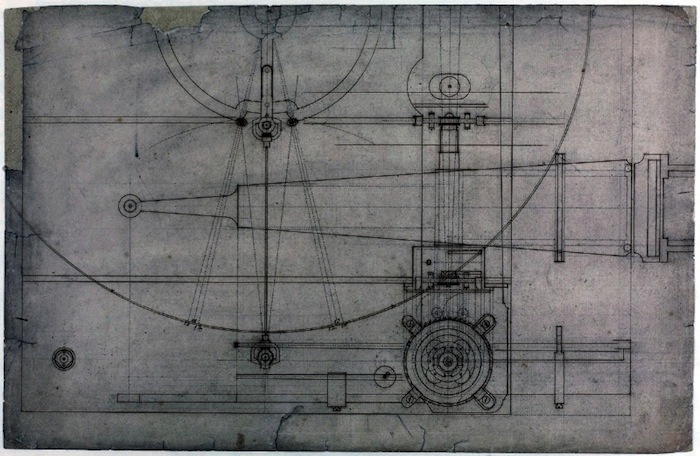In October 2023, Design Observer will celebrate its twentieth birthday. Throughout the year, we’ll be highlighting stories we’ve published over the last two decades, revisiting transformative ideas as we examine what’s continued to resonate, what’s missing, and what matters.
We begin this month with science and art.

Drawing by John Harrison of his 1761 chronometer
It used to be that time defined information. We watched the nine o’clock News, got the morning papers, and listened to the radio for the noon updates. Now it is the other way around—information defines time. A text message chimes its arrival, emails push themselves onto your tablet or smartphone and looking at Twitter can become as bad a habit as smoking. Church bells or the town crier once coordinated time in our cities while the rhythm of country life was determined by seasons, the weather, the animal kingdom. When mechanical clocks appeared in the thirteenth century, they took their name from the Latin clocca, meaning “bell”; they were installed in the center of town so that everybody could hear them ring. They provided the coordinates for daily life.
All time was local, and journeys were measured not by distance but by the time it took to travel them. Once trains could cover more than one local time zone between sunrise and sunset, the world needed a common system to measure time. It may seem banal, but Greenwich Mean Time was introduced to facilitate the coordination of railway timetables.
Being able to measure and tell time precisely changed not only travel but also the way we worked and lived. The invention of wearable watches changed our habits even more than central clocks on bell towers did (most of them had only an hour hand—minutes didn’t matter then). A farmer without a watch knew no haste, but the factory worker had to clock in, and minutes missed would add up to hours unpaid.
Pocket watches were in use well before the Age of Enlightenment, and being able to measure time precisely helped people think about what happened elsewhere at the same time. The answers to existential questions were not left to remain unanswered by some unquestionable divine authority but were sought in science. Precise timekeeping enabled scientific experiments and freed people from the constraints of clerical explanations for everything they couldn’t understand. Without the measuring of time, precise navigation was impossible. The position of a ship could be determined with the help of a clock that didn’t lose or gain less than ten seconds a day. John Harrison’s clock of 1761 kept time to within five seconds over ten weeks. Finally, navigators could determine longitude accurately. Harrison deserved his reward of £20,000, equivalent to millions today. His clock made the rapid expansion of the British Empire possible, and measuring time fueled industry. Efficiency in large production systems is unthinkable without precise clocks.
Time attained a mechanical dimension in industrial societies that it had never before had, not in thousands of years. Weekly timesheets, quarterly results, annual reports, the separation of working hours from free time, working life, retirement—these are all unthinkable without timekeeping. Time now is money: rare and thus precious. Stock exchanges are run by computers that make deals within nanoseconds, too fast for us to comprehend or interfere with. While the first clock towers served a social function as the coordinators of town life, we now witness the conflict between real time and Internet time. Google knows what it means when you watch a movie as it is broadcast on TV or later, online. We also tell a lot about ourselves when we send emails at 4:30 in the morning or download movies in the middle of the day, perhaps to our office computer. We can be present in many time zones at once. It is always six hours earlier somewhere else, possibly on Facebook where we read the latest news. Or six hours later, when you book a table for the evening or tickets for a concert. Google draws conclusions from what it calls predictive search, like when you’re checking how long something will take you or where exactly you’re going.
We no longer look for repetition, as Marshall McLuhan said, but for many different rhythms—it is the difference between marching soldiers and a ballet. The world is totally connected and digitized. There is no more “now.” We all have to know our way through many time zones at once. We spend a lot of time trying to catch up. But how much more do we know about what we just read? How much time do we waste because we read lies and invention? The only reason for newspapers or serious news stations might soon be the fact that they appear only once a day, organizing the world on biological terms again, following the rising and the setting of the sun. (Or the cycles of the moon, if we are talking about monthly publications.) Making time once again an exclusive commodity may well create a new market for the dinosaurs from the Gutenberg age.
This article originally appeared in the October 2011 issue of Blueprint
